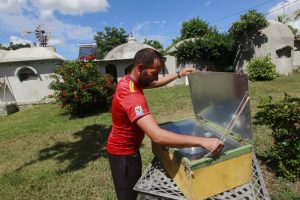
Lorenzo Díaz, son-in-law of José Antonio Casimiro, uses a solar oven to cook food. In the background, a windmill and a solar heater are other technologies in the clean energy mix that the family has installed at their Finca del Medio farm in central Cuba. CREDIT: Jorge Luis Baños / IPS
By Luis Brizuela and Jorge Luis Baños
TAGUASCO, Cuba, Dec 12 2023 – The combined use of clean energies allows Finca del Medio, a farm in central Cuba, to practice a unique system of family farming production that guarantees self-sufficiency based on permaculture, agroecology and care of the environment.
For three decades, 65-year-old farmer José Antonio Casimiro and his family have been applying innovations to take advantage of the solar, wind, hydraulic and biomass potential on their 13-hectare farm in the municipality of Taguasco in the central Cuban province of Sancti Spíritus.
Casimiro and his wife Mileidy Rodríguez, also 65, settled in 1993 with their children Leidy and José Antonio – Chavely was born a year later – on their paternal grandparents’ farm and began working to reverse the deterioration of the infrastructure and soil erosion.
The family, who live on the farm except for the eldest daughter, is currently self-sufficient in rice, beans, tubers, vegetables, milk, eggs, honey, meat, fish and fruit. Of the basic foodstuffs, they only have to buy sugar and salt, and the surplus they produce is sold in surrounding areas.
They also promote education and awareness-raising on good agricultural and environmental practices, on the social networks.
At Finca del Medio, a number of daily processes are supported by clean sources such as electricity generation, lighting, water supply, irrigation and water heating, as well as cooking, dehydration and drying of foods, and baking and refrigeration of food.
The farmer commented that the farm produces the equivalent of about 20 kilowatt hours (kWh) from a combination of multiple technologies and innovations that utilize the potential of clean energy sources.
If only conventional electricity were used for their activities, it would cost them around 10,000 pesos (83 dollars) per month, he said.
Their 28 solar panels, which produce about 8 kWh, increased the power for water collection, irrigation and supply, while three solar heaters ensure hot water for domestic needs such as bathing.
The hydraulic ram uses the water pressure itself as the only energy to extract it from a dam with a capacity of 55,000 cubic meters, pipe it to a tank at the highest part of the farm, and from there the slope is used for irrigation by gravity, or to fill the animals’ water troughs.
Next to the kitchen, two fixed-dome biodigesters provide biogas, obtained from the anaerobic decomposition of animal manure, crop waste and even household sewage.
Due to a decrease in the amount of manure, only one of the biodigesters is operating, which provides about seven meters of biogas per day, enough for cooking, baking and dehydrating food.
The innovative family devised a mechanism to extract – without emptying the pond of water or stopping biogas production – from the bottom the solids used as biofertilizers, as well as hundreds of liters of effluent for fertigation (a combination of organic fertilizers and water) of the crops, by gravity.
The installation of the biodigesters, the solar panels and one of the solar heaters was supported by the Swiss Agency for Development and Cooperation (Cosude) and the Indio Hatuey Experimental Station of Pastures and Forages through its Biomass-Cuba project, Casimiro said.
The agro-ecological innovator also highlighted the link with other scientific institutions such as the Integrated Center for Appropriate Technologies, in the central province of Camagüey, which is focused on offering solutions to the needs of water supply and environmental sanitation, and played an essential role in the installation of the hydraulic ram.
The family also has two windmills and an efficient stove that uses firewood, coconut shells and other waste to cook food, dehydrate fruits and spices, heat water and treat meats for preservation.
Casimiro is in favor of incorporating renewable energy sources into agricultural processes. But in his opinion, “More incentives, better policies and financial support are needed so that farming families have sufficient energy for their work and can improve the comfort of their homes and quality of life.”
Clean sources account for only five percent of electricity generation in this Caribbean archipelago of 11 million inhabitants.
The government considers it a matter of national security to modify the national energy mix, which is highly dependent on fossil fuel imports and hit by cyclical energy deficits.